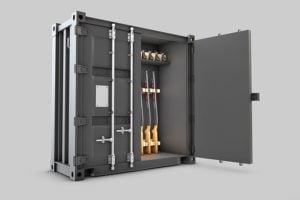How to Pack Books
Most of us don’t give books any special consideration while moving them. Whether you are moving old textbooks, paperback novels or a prized collection of first editions, properly packing your books will prolong their shelf life and prevent damage.
Supplies needed: Packing books is relatively easy and takes very few resources; all you need are small boxes, blank newsprint and packing tape. The boxes should be small as paper is very heavy and large boxes filled with books would be very difficult to move.
Instructions:
- Prepare a small, sturdy box by double taping the bottom.
- You can pack the books one of three ways, depending on the size of the book and the box. You can pack them straight up (like on a library shelf), on their side, or with their spines down. If you are packing them on their side, you want to pack the largest books on the bottom, and the smallest on top. Any combination of these directions will work; the idea is to pack a small box as full as possible and prevent the books from shifting around and being damaged during the move.
- Fill any extra space with crumpled blank newsprint. Slightly overfilling the box with newsprint is preferable to leaving room for the books to shift during transport.
- Make sure the box weighs around 30 pounds. Seal and mark box.
- For prized books that you want to maintain in excellent condition, wrap every book individually with packing paper. If your books are bound in paper or a limp binding (i.e. leather-bound books), reinforce the covers with colorless cardboard before wrapping them.
- Once the books are boxed and sealed, do not to leave the box on the floor, as moisture and condensation can damage the books.
- Avoid filling empty space in the boxes with any loose items that could potentially damage the books.
How to Pack & Move Your Computer
Your computer needs special care during the moving process. Not only is computer hardware valuable, but data is often irreplaceable. Computers are delicate electronic devices and you should make sure that they are safely packed, and your important files are backed up. If you have a laptop, just put it in your regular laptop carrying case and take it with you in the car during your move. Otherwise, follow the steps below to ensure safe delivery of your computer.
1. Back It Up
The data that you have on your computer can often be of more value than the computer itself. Protect your financial records, family photos, music collections and the countless other files on your computer by making a backup of your important data before your move. If you have a DVD-R or CD-R drive with the ability to “burn” data (save data to a blank disc), you can make copies of all your files. If you don’t have a recordable disc drive, then you should consider a USB memory drive. They are cheap, safe and can store quite a bit of data. You also have the option of an external hard drive, which can store huge amounts of data and back your computer up completely.
When backing up your files, don’t forget:
- Documents, spreadsheets, and presentations
- Pictures
- Music files
- System settings, like favorite websites
- Emails
- Financial records
- Saved passwords
2. Disconnect the Cables
Once you are done backing up your files, shut off your computer, monitor and any peripherals and disconnect all the cables, starting with power cables. If you’re not very familiar with setting up a computer, make sure you label the cables as you disconnect them. “Twisty ties” or Velcro ties are really useful for keeping cables organized. Store all the cords in a separate box than your computer and don’t forget to wrap your keyboard, mouse and other components before packing them away.
3. Wrap it, Pack it and Seal it
Once your data is backed up and your cables safely stored away, it’s time to pack your computer. The best option is to use the original packaging or purchase a computer packing kit complete with padding at any moving supply store.
Pack your computer upright, or with the motherboard side down. You want to make sure that the box is padded well enough so the computer is snug in the box. Protect your computer by wrapping it in bubble wrap and filling empty space with padding such as packing peanuts or paper so it doesn’t take damage on the road.
Your monitor should receive equal care. Protect the screen with padding and ensure the box is not too large. For the older CRT monitors, pack them with the screen side down, properly cushioned with bubble wrap or packing paper. For flat screen monitors, you can pack them much like packing a mirror. If you can’t get a specialty box, make sure that the bottom is sturdy and well cushioned to protect it from damage.
Keyboards, mice and cables should go in the same box as your computer if there is room. For multiple computers, make sure to pack each computer’s peripherals in their respective boxes. Mark all boxes with computer equipment as “FRAGILE” along with the room in your new house they belong in.
4. That’s a Wrap!
With your computer safely packed away, the only thing left is to put it back together when you arrive. As a safety precaution, you will want to plug your power cable in last. Once your computer is up and running, do a quick check to make sure everything is working correctly and you haven’t lost any data.




